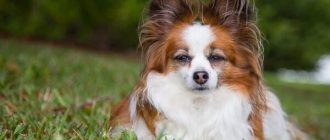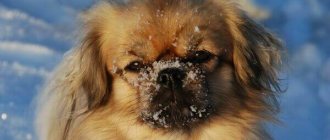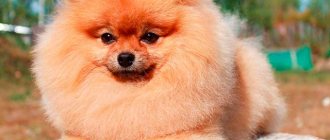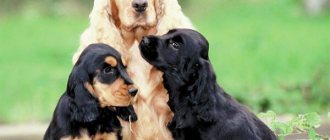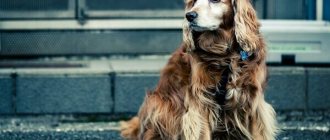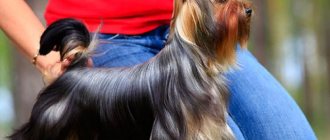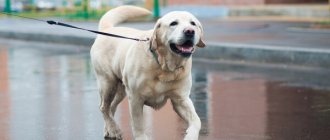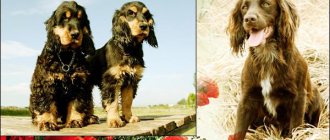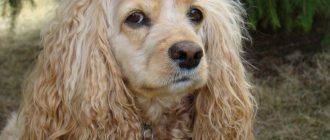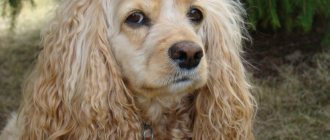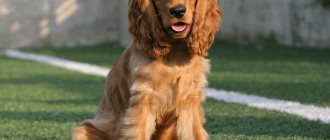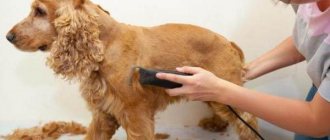Spaniels are the general name for a large group of breeds, which primarily includes hunting dogs, but also includes decorative and even dwarf pets.
The Mini Cocker Spaniel is a beautiful hunting dog of miniature size, considered the smallest among all gun breeds.
Despite the fact that they have not lost the hunting instincts of their ancestors, nowadays miniature cockers are much more often used as companions and family pets than for their original purpose.
They are also popular as participants in exhibitions and sports competitions, for example, freestyle skiing.
After all, in addition to their beautiful and impressive appearance, these dogs are very smart, quick-witted and willing to learn new skills.
Are there mini cocker spaniels?
There is no breed called a mini cocker spaniel . Usually, when it comes to the smallest cockers, we mean dogs of the American Cocker Spaniel breed.
All advertisements for the sale of mini cocker spaniels are either fraudulent, when breeders try to sell ordinary English or American cockers under the guise of a rare breed, or the puppies offered suffer from a genetic disease called dwarfism.
It is also likely that puppies sold as Miniature Cocker Spaniels were simply deliberately underfed by the breeder so that they could be sold for more than standard-sized puppies .
Breeds from the same group
- Australian (kangaroo) greyhound
- Australian Terrier
- Austrian Shorthaired Pinscher
- Azawakh
- Ainu (Hokkaido Inu, Ainu-ken, Hokkaido dog, Hokkaido)
- Akita Inu
- Alopekis
- Alaskan Malamute
- American Blue Gascony Hound (Big and Blue)
- American Indian dog
- American Cocker Spaniel
- American Staffordshire Terrier
- American Toy Terrier (American Toy Fox Terrier)
- American Foxhound (American Foxhound)
- Amur Laika (Indana)
- Anatolian Shepherd
- English Beagle
- English cocker spaniel
- English Pointer (Pointer)
- English Setter (Laverack)
- English Foxhound (Foxhound, American Foxhound)
- Dogo Argentino (Argentine Mastiff, Dogo Argentino)
- Artois Hound (Chien d'Artois)
- Ariège marriage (Ariege pointer, artesien Norman, bracque de Toulouse)
- Afghan Aboriginal Hound (Bakhmul)
- Afghan Hound (Afghan)
- Africanis (lion dogs)
- African hairless dog
- Affen pinscher (monkey pinscher)
- Bakhmul (Afghan Aboriginal Hound)
- Banjar Greyhound
- Basenji (Nyam Nyam Terrier)
- Basset Hound
- Batak Spitz (Pomeranian dog, Batak dog of Sumatra)
- Bedlington Terrier (Rothbury Terrier)
- Beagle Harrier
- Billy (Biya)
- Dogue de Bordeaux (Dogue de Aquitaine, French Mastiff)
- Bosnian Barrack (Bosanski Gonjic, Bosnian Rough-haired Hound, Ke
- Fila Brasileiro (Fila Brasileiro, Brazilian Mastiff, Brazilian Mol
- Breton fawn basset (Breton Basset, Red Breton Basset)
- Bourbon braque
- Buryat-Mongolian wolfhound (Hottosho)
- Wachtelhund (German Spaniel, German Quail Dog)
- Welsh Springer Spaniel
- Welsh Terrier
- Hungarian Greyhound (Magyar Agar)
- Hungarian Vizsla (Vizsla, Hungarian Shorthaired Pointer, Hungarian
- East Siberian Laika
- West Highland White Terrier (West Highland White Terrier, White Highland
- Hanoverian Hound
- Smooth Fox Terrier
- Blue Gascony Griffon
- Hamilton's Hound (Hamiltonstövare)
- Greyhound (English greyhound)
- Greenland dog (Greenland dog)
- Greek hare hound (Hellenic Iknilatis)
- Griffon cortalsa (French Wirehaired Pointer Griffon)
- Jack Russell Terrier
- Jämtland Laika (Emthund, Yemthund, Yamthund, or Swedish Elkhound,
- Wire Fox Terrier
- West Siberian Laika
- Golden retriever
- Irish Water Spaniel
- Irish Wolfhound
- Irish Setter
- Irish Terrier
- Spanish Water Dog (Perro De Acqua Español)
- Italian Segujo (Italian Hound)
- Kai (Brind dog, Kai, Tora Inu, koshu-tora, kai-ken, deer hunting
- Cane Corso Italiano
- Keeshond, Wolfspitz
- Cairn Terrier
- Kerry Blue Terrier
- Kyrgyz Shepherd
- Kishu (Kishu-inu, Kishu-ken)
- Clumber Spaniel
- Cocker Spaniel
- Kromforlander
- Labrador Retriever
- Laika
- Latvian hound
- Levesque
- Lesser Swiss Hound
- Lesser Vendean Basset Griffon (Petit Basset Griffon)
- German Wirehaired Pointer (Drathaar)
- German Hunting Terrier (German Jagdterrier)
- Nova Scotia Retriever (Nova Scotia Duck Retriever, Norwich Terrier
- Norwegian Elkhound (Norwegian Elkhound)
- Norwegian Lundehund (Norwegian Puffin Husky, Norsk Lundehund, Lun
- Norwegian Elghound black
- Ogar (Polish Ogar)
- Otterhound (Otter Hound)
- Parson Jack Russell Terrier
- Pitbull
- Podenco Canario
- Pointer (English Pointer)
- Polish Hound (Polish Ogar)
- Polish ogar
- Portuguese Water Dog (Cao De Acqua)
- Portuguese Podengo
- Poodle
- Rhodesian Ridgeback
- Romanian Mioritic Shepherd Dog
- Russian hunting spaniel
- Russian Spaniel
- Russian-European Laika
- Samoyed dog (Samoyed, Samoyed Spitz)
- Saint-Germain Bracque
- Serbian Hound (Balkan Hound, Yugoslav Hound)
- Stabihon (stabihunzhe, stebihun)
- Taigan (Kyrgyz Greyhound)
- Thai Ridgeback
- Dachshund
- Whippet
- Pharaoh Hound (Pharao Hound, Old Egyptian Greyhound)
- Finnish Hound (Tricolored Finnish Hound, Suomenajokoira)
- French white and orange hound
- Harrier dog
- Cirneco dell'Etna (Sicilian Greyhound)
- Shar Pei
- Silky Windhound (Silky Whippet, Windhound, Small Borhound
- Shikoku (Shikoku, Kochi-ken, Mikawa Inu)
- Styrian hound (Styrian marriage, Styrian rough-haired highland
- Epagnole Pont Audemer
- Airedale
Origin story and what it looks like in the photo
Spaniels, whose homeland is Spain, were brought to Britain back in the 12th century AD.
Already by the 14th century, the breed was divided into water and land spaniels. With the former they hunted water game, and with the latter they hunted land game, and it was from a small variety of land spaniels that cockers originated. They hunted with them mainly small birds, mainly woodcocks.
In 1620, cockers were brought to the New World, and from that time a new stage in the development of this breed began. However, at this time it was not yet possible to talk about their American variety as a separate breed.
Even in the second half of the 19th century, when English cockers were already officially recognized and took part in exhibitions, American-bred dogs continued to be crossed with them, although by that time they were already somewhat different from the original breed in their appearance.
The ancestor of the American cocker is considered to be a dog named Obo the Second, born in the USA in August 1882 and distinguished by its very small size for dogs of that time: his height was only 25 cm at the withers.
Despite the fact that Obo the Second was very different from modern cockers in physique and had a very stretched body, he was considered very good in conformation for his time and became an outstanding sire.
At the beginning of the 20th century, standards were developed on both sides of the Atlantic and even then it became clear that the American variety of cockers was very different from the English one.
In 1935, the final division took place: English-type dogs were recognized as standard cockers, and American ones were excluded from breeding.
However, in 1946, the AKC recognized the American variety as a separate breed, after which international recognition of these dogs took place..
Application
Other experiments with Baker-Miller pink are also known. The color was used at the Santa Clara County Jail in San Jose and the Kuiper Center for Juvenile Offenders. In addition, in 2006, a punishment cell in the Swiss district of Pfäffikon was painted pink: the experience was considered successful, and it was soon repeated in more than ten penitentiary and psychiatric institutions in Switzerland, Germany and Luxembourg.
In 1979, the visiting team's locker room, including showers and urinals, was painted pink at the University of Iowa football stadium. The idea belonged to the coach of the local team, Hayden Fry, who recalled this episode in his memoirs: “We hoped that this color would evoke a passive mood among our opponents.” In the early 1990s, guest rooms at the University of Colorado Stadium also became pink, but then the leadership of the Western Division of the American Football Conference decided that both teams' locker rooms must be the same color.
Character traits
Miniature Cockers are lively, energetic and playful dogs that are intelligent, quick-witted and inquisitive.
They are very friendly towards people, become very attached to their owners and are great with children..
At the same time, if desired, such a pet can be raised into a wonderful hunting assistant, which, despite its small size, will track, fly, and even bring shot game to its owner no worse than other spaniels.
Mini Cockers are also suitable as sports dogs and, although disciplines such as dragging loads are unacceptable for them, many American Cockers show excellent results in agility, freestyle and other sports that require agility and artistry.
Expert opinion
Kozhevin Semyon Kirillovich
Expert dog handler.
“The Mini Cocker Spaniel, despite its small size, is agile, agile and energetic. This is a dog that is equally suitable as a pet or a working dog. However, mini-cockers are not often used nowadays for their original purpose, since many hunters are not satisfied with the labor-intensive care of their coat, and therefore they prefer shorter-haired breeds. But at the same time, thanks to their spectacular appearance and friendly disposition, American cockers are popular as pets and show dogs.”
Interesting Facts
There are many interesting facts about the cockapoo breed. Here are a few of them:
- Cockapoos are hypoallergenic dogs, so they can live in an apartment or house with people prone to allergies.
- A cockapoo named Alfie won the title of "Dog with a Smile" in a competition run by Penguin Books. According to the jury, this animal is constantly smiling. Many breeds competed for this award, but the 9-month-old Cocker Poodle was awarded the award.
- The breed is popular not only in America; its qualities are also appreciated in Sweden, Australia and Great Britain.
The breed is ideal for participation in beauty contests
Cockapoo is a person's best friend and cheerful companion. He is able to empathize with his owner and at the same time try to cheer him up, which cannot but be appreciated.
Advantages and disadvantages
pros:
- Beautiful appearance.
- Very smart and quick-witted.
- They are loyal to their owners and love to please them.
- Friendly attitude towards people.
- They get along well with children.
- Not aggressive towards other pets.
- Playfulness and energy.
- Small convenient size.
Minuses:
- Quite labor-intensive and expensive grooming and the need for haircuts.
- Needs long walks.
- Quite gluttonous and prone to obesity.
- Excessive trust in strangers.
- Hunting instincts can cause a pet to escape if a mini cocker rushes to chase a bird or, for example, a neighbor's cat.
Price range
The price for a dog of this breed ranges from 25 to 35 thousand rubles. At the same time, puppies belonging to the pet class will cost 15-20 thousand rubles, and the price for show class puppies starts from 70 thousand rubles*
The Dwarf Cocker Spaniel is a miniature version of the hunting Cocker Spaniel breed. The animal has an energetic and playful character and gets along well with children and other animals. The appearance of the mini spaniel and the description of the breed speak of its decorative qualities, which are largely due to its long silky hair, hanging ears and large, kind eyes.
Dimensions, weight and other distinctive features
| Options | Data |
| Height | Males - 38-40 cm Bitches - 35-36 cm |
| Weight | Males – 11-15 kg Bitches – 8-10 kg |
| Frame | Strong and compact, with a strong, straight back and a moderately broad, well-developed chest. |
| Head | Harmonious and proportional to the body, with a well-defined stop. The length of the muzzle, shaped like a square, should be approximately half the total length of the head. |
| Ears | Long, hanging, set low - in line with the eyes. |
| Eyes | Large, expressive, always dark, almond-shaped or round. The expression of the eyes is benevolent and meek. |
| Nose | Depending on the color, it can be either black or brown. |
| Neck | Elongated, graceful, slightly curved. |
| Limbs | Strong and strong, without signs of disintegration. |
| Tail | Previously, it was docked in puppyhood, but now it can be left at natural length, since this does not contradict the breed standard. |
| Wool | Straight or slightly wavy. Quite short on the head, but long on the ears and body. At the bottom of the body and on the paws it forms a so-called skirt. The coat is silky and pleasant to the touch, without the slightest signs of coarseness or, conversely, excessive fluffiness and cottoniness. |
| Color | It can be either one-color (fawn, red, brown, black), or two-color or three-color. Black and tan and brown American cockers are also found. |
The edge of the dog's ear, if extended in length, should reach the edge of the nose with its tip.
Lifespan
The average lifespan of miniature cockers is 13-15 years.
However, dogs of this breed may be susceptible to the following diseases::
- Dysplasia
- Cataract
- Progressive retinal atrophy
- Corneal dystrophy
- Glaucoma
- Hemolytic anemia.
- Allergy
- Otitis and other inflammatory diseases of the ears.
- Dilactation cardiomyopathy.
- Epilepsy
The life expectancy and health status of a pet primarily depends on its heredity and conditions of detention..
Health
Cockapoos live up to 13 and sometimes up to 15 years. To keep your pet healthy, it must be taken to the veterinarian for a routine examination. And also you can’t ignore vaccinations. Breeders have not been able to achieve maximum disease resistance in dogs. Therefore, cockapoos can be susceptible to various ailments. Animals are prone to allergic reactions and epilepsy.
If your pet eats improperly, he or she may develop problems with the stomach, intestines, and sometimes even the liver.
If you do not pay attention to hygiene, your dog may develop dermatitis. Infections may cause hearing and vision problems
Watch the video from the dog owner's home archive below.
Care and maintenance
Caring for the coat of these dogs is quite difficult. Miniature cockers need bathing no more than once a week. In this case, it is necessary to use special cosmetics that will not only make your pet’s fur clean, but also improve its quality.
Brush your cocker regularly to prevent tangling of the coat . In addition, dogs of this breed require periodic haircuts.
Due to the fact that American Cockers can be susceptible to allergies, it is recommended to use hypoallergenic shampoos and conditioners when washing them.
Your pet’s long ears need to be inspected every day and cleaned if dirty..
The visible part of the ear canal of a miniature cocker is cleaned with cotton swabs and a special lotion, and the inside of the ear is wiped with a damp cloth.
IMPORTANT!
The dog's eyes can be wiped with cotton swabs soaked in a special eye cleaner.
The claws are trimmed with a nail clipper as they grow, that is, when their tips begin to curl inward.
The Miniature Cocker's teeth also need care: they need to be periodically cleaned and the condition of the gums monitored.
It is recommended to clean them using special treats or toys, but if plaque is not removed by these methods, then you can brush the animal’s teeth with a brush and toothpaste for dogs.
In the same case, if hardened plaque appears on the teeth, you should contact a veterinary clinic to have it removed.
Varieties
Spaniels are small or small dogs, but they have their own characteristics in maintenance and care. You need to approach the choice intelligently and first read about the types of spaniel breeds with a description.
English cocker spaniel
Photo from Wikipedia website
English Cockers are descended from Norfolks, ancient hunting dogs. They hunt birds, their sensitive nose and sharp eyesight help them in this.
The English are stocky dogs of medium height with a long body. Height – up to 40 centimeters, weight – up to 12-15 kilograms. They have large drooping ears and wavy fur. They are dexterous and strong, fit, but without care and proper physical activity, dogs begin to be lazy and quickly gain weight.
English Cockers are predominantly red, white and black. There are standard representatives of the breed and mini varieties. The British are family men. They love spending time with people and are good with children. They always capture the mood of the owner and the general atmosphere of the house. They treat strangers with caution. They do not communicate with cats and small animals.
English Springer Spaniel
Photo from Wikipedia website
Springers are the oldest breed of hunting dogs. They are the ancestors of all modern spaniels. For centuries, springers were companions of English lords. They earned the love of Renaissance artists and can often be found in famous paintings.
There are two types of springers: hunters and show dogs. Externally, they do not differ from each other, but they have different skills and differently developed instincts. This is a large and muscular dog, fast and agile in its movements. It grows to 45-55 centimeters and weighs up to 30 kilograms. The coat has weak waves and lies close to the body. White and brown or black.
Springer is the ideal family man. He is kind, loyal, active. Loves to play with children and accompany adults on runs. Such dogs are an ideal choice for active people who have time for walks.
American Cocker Spaniel
Photo from Wikipedia website
American cockers are considered one of the most charming and graceful dogs. They originated from the English breed. A dog from one of the breeders gave birth to puppies with big eyes and wavy hair. In England they were not accepted, but in the United States of America they became a separate branch of spaniels. Already in the 1930s, the British and Americans were recognized as different breeds and were no longer crossed.
Americans are smaller than the British: height reaches 37-40 centimeters, weight - 12-14 kilograms. They have a more snub-nosed muzzle and a silky coat that resembles flowing curls. Color white, black or brown.
This is the ideal family man who fits into life in the city. They are less active, do not require long walks and too active games. At the same time, they are more affectionate and good-natured, strongly attached to their owner and suffer in his absence. However, their mood can be changeable. Do not disturb your dog if it needs solitude or peace.
American Water Spaniel
Photo from Wikipedia website
American water spaniels are not particularly well known in the world, but in their homeland they have gained love and popularity. The exact origin is not known: some call their ancestors Irish mermans, others call them curly-coated retrievers. Like other representatives, mermen are excellent hunters. They are usually taken with them when hunting hares and waterfowl.
Americans are large and stocky. They grow up to 60 centimeters and weigh up to 30 kilograms. They can be recognized by their thick and curly fur of a deep chocolate shade. The muzzle is smooth, and there is no hair at all on the tail. They are very hardy, but at the same time genetics have given them serious diseases that manifest themselves in many representatives.
Water spaniels are smart, picking up commands on the fly. Due to these qualities, they are often trained in circus tricks. They are sociable and active. They quickly become attached to their family and are ready to protect them from any troubles.
Kooikerhondje
Photo from Wikipedia website
Kooikerhondje comes from Holland. The name literally translates as “duck hunter.” They are distinguished by a unique hunting style: by wagging their tail and moving, they attract ducks to the shore where people have set traps. Dutchies are small and have a square body. Height – 40 centimeters, weight – 15 kilograms. The coat is white with red markings. It has the ability to repel water and dirt, which is valuable during hunting.
The main purpose of the Kooikerhondje is hunting. His "family" skills are not as developed as other spaniels. They are attached to their owners, but remain calm and reserved. They are indifferent to children and prefer to stay away from them. They do not like loud screams and laughter. They need training and moderate physical activity.
Irish Water Spaniel
Photo from Wikipedia website
This is the largest representative of the group. They are large and heavy. At the withers, the height reaches 60 centimeters, and the weight reaches 35 kilograms. They are not well suited for apartment life, as they need fresh air and space for activities. Following their hunting instincts is important to them.
The peculiarity of the Irish is wool. They are covered with soft curls of a dark chocolate color. Sometimes dogs have bangs and a goatee. The ears are covered with fur.
Despite their short stature, the Irish are often cowardly. Their fear can turn into aggression. They need proper upbringing, and then the pet will grow up loyal, affectionate and obedient. Quiet, calm disposition.
Cavalier King Charles Spaniel
Photo from Wikipedia website
One of the oldest representatives of the group. For several centuries, Cavalier King Charles was a favorite of the English nobility. They were originally bred for hunting, but then the courtiers began to want to take them home. However, they were too large to be kept indoors, so breeders crossed them with Tibetan Spaniels and Japanese Chins.
The result was the Cavalier King Charles, a small dog with a round, flat muzzle. Height is only 30-32 centimeters, weight does not exceed 8 kilograms. The body is compact. The coat is white with brown, red or black markings.
Cavaliers have truly “royal” endurance. They are calm and balanced. They do not lose face when interacting with children and small animals. They love to be the center of attention and catch people's gazes. This is an excellent choice for those who want to take their dog to shows.
Clumber
Photo from Wikipedia website
This is the heaviest representative of the group. The height at the withers is 50 centimeters, but the weight reaches 35 kilograms. The breed has always been considered elite and was popular among rich people. This is a real “blue blood” among dogs.
They were bred to hunt pheasants and partridges. Judging by their faces, it seems that Clumbers constantly want to sleep, their gait is dragging, but appearances are deceiving. Thanks to their well-developed sense of smell and vision, they are natural hunters.
Compared to others, they are not as active. Calmness, kindness and complaisance are their main qualities. Well suited for apartment maintenance. They get along with children and other animals, but avoid strangers.
The coat is white, with lemon spots. Due to its thickness, it requires regular care. Future owners should pay attention to the fact that Clumbers drool. They need proper upbringing, otherwise they will start to cheat and open food cupboards and spoil things.
German Wachtelhund
Photo from Wikipedia website
The breed was bred to lift birds into the air. This is a born hunter and a good friend. Wachtelhunds are highly trainable, but they will forget all the skills they have learned if their energy is not released. The Germans need to be given physical and mental stress. It is difficult to keep them in an apartment, since it is important for them to be able to run around. When keeping them in an apartment, you need to walk them for at least 4 hours, which is problematic for most owners.
Wachtelhunds are strong and muscular. The height at the withers reaches 55 centimeters, weight reaches 25 kilograms. The wool has weak waves. It is thick and dark chestnut in color. Occasionally there are dogs with white spots on the chest and paws.
The dogs are friendly, affectionate and obedient. But to achieve this, the owner must prove his leadership. Only by showing who the leader is can you get a loyal friend in return. This must be done with confidence and patience, and not with loud words.
Continental Toy Spaniel (Papillon)
Photo from Wikipedia website
This is one of the most ancient and rare breeds. The name translates as “butterfly”. It has to do with the shape of the ears. Papillons come from France, where they gained the love of the royal court. The ladies of the court could not imagine going out without a papillon. However, with the advent of fashion for pugs, their popularity decreased.
Compared to other spaniels, the Papillon is quite small, although strong. It does not exceed 28 centimeters and weighs no more than 4 kilograms. The wool is long. The ears are erect and fringed with wool. Well suited for apartment maintenance. Wool needs regular grooming. By nature, Papillons are not sugar. They are so smart and cunning that with age they learn to manipulate their owners. Only proper training will make them loyal friends who know how to listen and adapt to people.
Russian hunting spaniel
Photo from Wikipedia website
This is an unrecognized breed. She doesn't have a specific standard. It appeared in the USSR after the end of the Great Patriotic War as a result of improper work of breeders. Now breeders are trying to develop a single standard.
The Russian hunting dog is 35-45 centimeters tall and weighs 10-18 kilograms. The body is graceful. The coat is wavy. It can be one color or combine two or three colors. They are unpretentious in care, but need human attention. Dogs have a tendency to dig through trash and roll around on the ground and need to be supervised.
Dogs are smart. They are used for hunting, for military service and as companions. They are insightful and understand people's moods well. They are distinguished by courage, devotion and friendliness. They need a firm hand and education.
Sussex Spaniel
Photo from Wikipedia website
Sussexes are descendants of Clumbers, so they look similar in appearance. They were bred to sneak through thickets when hunting and bark loudly when they spotted game. In the world and at home - in England, they did not find much popularity.
Sussexes are generalists. They can hunt, serve as police bloodhounds and border guards, and watch TV with their owner. Their disposition is phlegmatic. They are kind, calm, and get along well with children. They value peace and do not need excessive activity.
The height of Sussexes is 38 centimeters, weight is 20-23 centimeters. Their muscles make them appear large. The coat is thick, medium length and golden chocolate in color.
Tibetan Spaniel
Photo from Wikipedia website
The Chinese variety of the group is not similar in appearance to other representatives. She is also called tibby. It does not grow higher than 24 centimeters, and its weight does not exceed 6 kilograms. Tibbies are small and compact. The body is elongated and the legs are short.
The breed was bred to sit on the walls of Tibetan temples and bark loudly when it saw a stranger. Now she is part of the group of decorative dogs, not hunting dogs.
The character of the Tibby has all the features that are characteristic of decorative dogs. They are calm and peaceful. They love people and do not show aggression. They prefer moderate games; their own comfort is important to them. They are difficult to train and can be stubborn.
Welsh Springer Spaniel
Photo from Wikipedia website
The breed appeared in Wales back in the 17th century. She knows how to find game buried in snow or leaves, is an excellent bird hunter and has excellent scent.
The Welsh Springer's character is flexible and kind. He does not show aggression, obeys his owner, but in the absence of proper activity, he begins to bark, snap, and run away without control. Welshies are active, love to play and easily get along with people and other animals.
The dogs are strong, muscular and round. Height – 46-48 centimeters, weight – 20 kilograms. The coat is white with chestnut or flame spots. Representatives of the breed are long-haired and short-haired.
Field Spaniel
Photo from Wikipedia website
Breeders wanted to create a black spaniel, but the result would be a chocolate brown field. The name is associated with the ideal conditions for keeping the breed - they like the open spaces of fields and physical work.
They are larger than many representatives: height – 52 centimeters, weight – 25 kilograms. However, other features are consistent with the group: a muscular, lean body, wavy fur and drooping ears. Webbed feet for swimming. The color is black, sometimes with white spots.
The Field's character is calm, obedient and friendly. It completely adapts to the owner: his lifestyle, mood and habits. However, the dog has pride, and it will not allow itself to be pushed around. Genetically, she has an attachment to her owner, and when separated she begins to feel sad.
Epagnole-Breton
Photo from Wikipedia website
The dog is originally from France, but has gained popularity throughout Europe and the United States. It was already known in the 17th century. Its images can be found on tapestries, but written sources mention the breed only from the 1850s. It was officially registered only in 1907. Epagnolas grow up to 52 centimeters and weigh up to 25 kilograms.
bushy, but not massive, but neat. They are similar to the Russian variety of the group, but taller. The most common colors are white-red and white-black.
The advantages of the breed include highly developed hunting instincts and intelligence. She is sociable and devoted to people. They love work. Exhibitions are not for them. This is an energetic and businesslike dog that does not like to sit idle.
Japanese Chin
Photo from Wikipedia website
Japanese Chins are a miniature version of Spaniels. They originated in Japan as companion dogs, but they are not without hunting instincts. The Khins enjoyed the love of the court and the emperor himself. For a long time they were not known about in Europe, and only in the 20th century did they gain fame.
Chins are small: height - 25 centimeters, weight does not exceed 4 kilograms. They are muscular and well built. The muzzle is wide. The coat is white with red or black spots, long.
The Japanese are ideal comrades. They adopt a person’s mood and adapt to his desires. They are smart and well understand the rules established in the house. They can be taught tricks. Chins have a lot of energy and love to walk and play. People are jealous of other animals.
Spaniels are a group of hunting breeds. They differ from each other in height and weight, character, habits. They are united by their love of hunting, energy and devotion to people. Among a group you cannot choose those who are worse or better. They are all devoted friends and good helpers. The only question is what kind of life a person leads, and what breed will be closer to his spirit.
Proper feeding
You can feed mini cocker spaniels natural food or ready-made food no lower than super-premium, or better yet, holistic-class. At the same time, if the dog is prone to allergies or obesity, you should opt for a special dietary food.
When feeding natural food, the basis of the diet should be cut into pieces and scalded raw lean meat.
You should add chopped vegetables (raw or boiled), as well as fermented milk products, such as cottage cheese or kefir.
When feeding your pet naturally, it is also necessary to add vitamins and mineral supplements to your pet’s food..
Photo gallery
The Cocker Spaniel is a very affectionate and sociable dog who will share both joyful and difficult moments with you. Let's look at photos of these cute dogs.
How to choose?
First of all, you should decide on the gender, color and quality of the future pet. If you decide to buy a show-class cocker, and gender does not matter, then it is better to opt for a male, as they look more impressive in the rings.
However, it should be taken into account that girls are more affectionate and obedient, and therefore, if there are children in the house, it is better to buy a bitch.
You should only buy a dog in a kennel or from a breeder, since purchasing a cocker on the market, and even without the puppy having documents of origin, can be fraught with the purchase of a mestizo, and not a purebred spaniel.
When choosing a baby from a litter, you need to carefully examine it to make sure that its appearance meets the standard requirements, and that its eyes, nose, ears and skin are clean and healthy.
CAREFULLY!
It is not recommended to purchase a puppy that shows anger towards people, cowardice or nervousness.
Also, you should not buy babies that are too small in size, since these puppies are often either undernourished or suffer from a hereditary disease such as dwarfism or, in other words, dwarfism.
